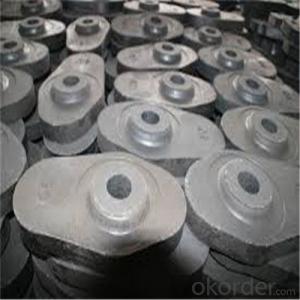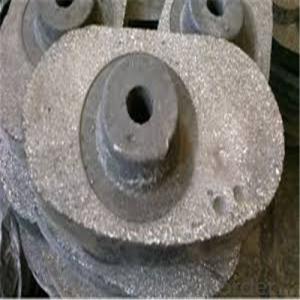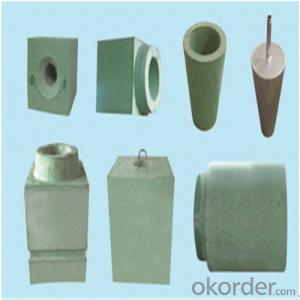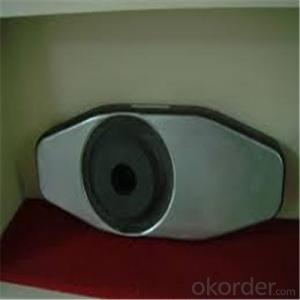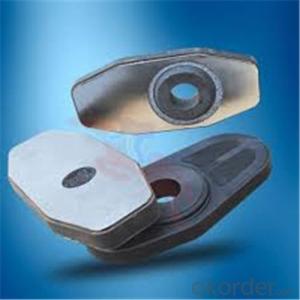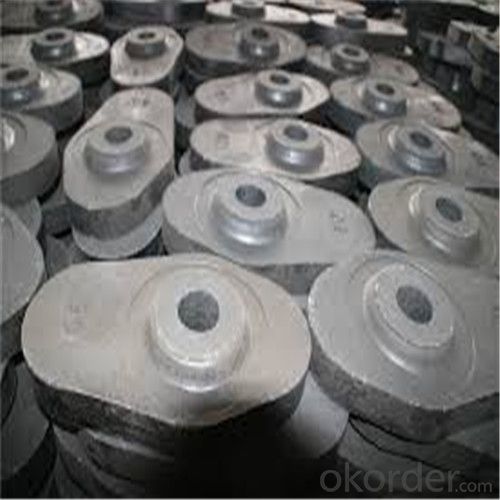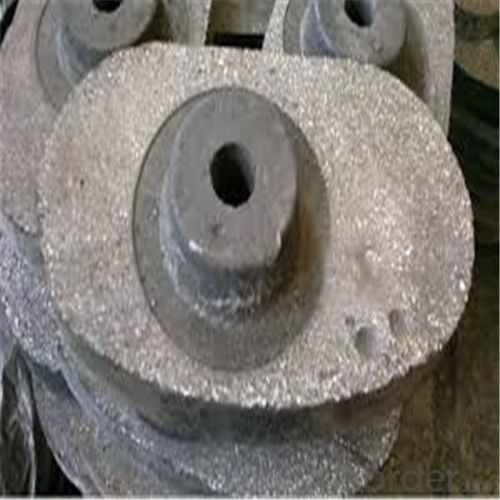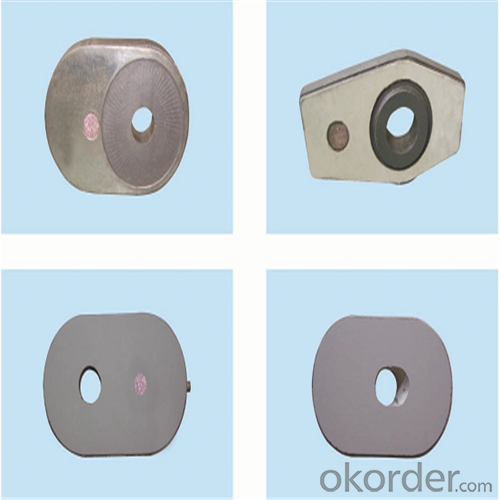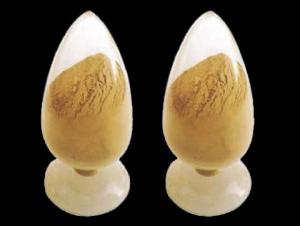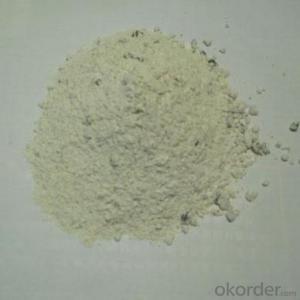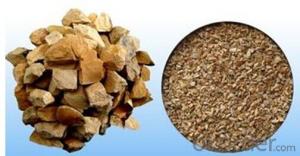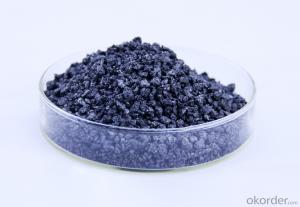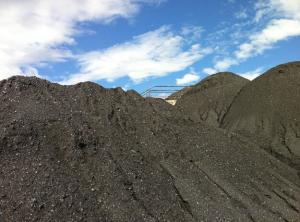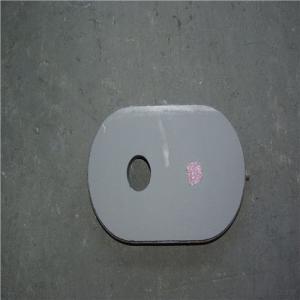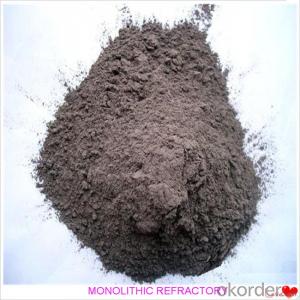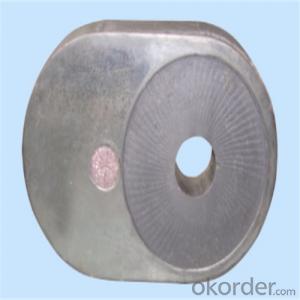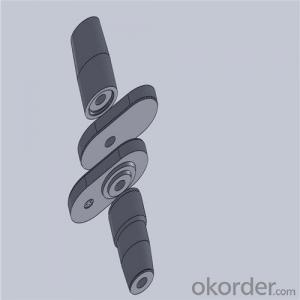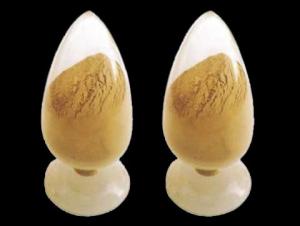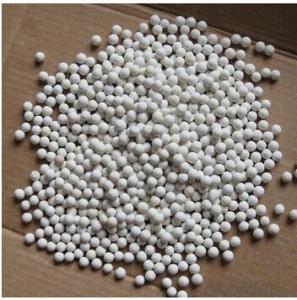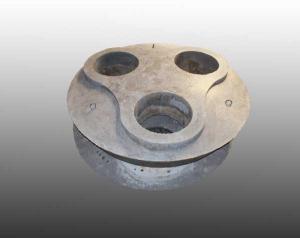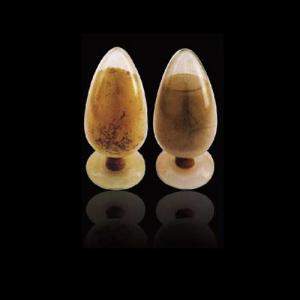Monolithic Refractories Ladle Sliding Gate for Iron and Steel Industry 2024
- Loading Port:
- Shanghai
- Payment Terms:
- TT OR LC
- Min Order Qty:
- 100 pc
- Supply Capability:
- 1000 pc/month
OKorder Service Pledge
OKorder Financial Service
You Might Also Like
Quick Details for High Performance Refractory Ladle Slide Gate
| Place of Origin: | China (Mainland) | Shape: | Plate | Material: | Alumina Block |
| SiO2 Content (%): | N/A | Al2O3 Content (%): | 80-90% | MgO Content (%): | N/A |
| CaO Content (%): | N/A | Refractoriness (Degree): | 1770°< Refractoriness< 2000° | CrO Content (%): | N/A |
| SiC Content (%): | N/A | Model Number: | CS80 | Brand Name: | |
| Product name: | High performance refractory ladle slide gate | Model No.: | cs80 | Brand name: | CMAX |
| Quality: | Al-C or Al-Zr-C | Service life: | 4-6 heats | Apparent porosity: | 7% Max |
| Bulk density:: | 3.1 MIN | C.C.S: | 120MPA | MOQ: | 100 pcs for trial |
| Delivery time: | 60 working days upon receipt of deposit |
Packaging & Delivery
| Packaging Details: | Inner carton packing, outer wooden case suitable for long term sea shipping |
| Delivery Detail: | three months working days upon receipt of deposit |
Specifications
Surface flatness less than 0.05mm
High mechanical strength
Erosion resistance
Oxidation resistance
Thermal shock stability
General Chemical Analysis for refractory ladle slide gate :
slide gate plate widely including Alumina carbon and Alumina Zirconia Carbon slide gate plate, MgO and MgO-spinel slide gate plate,nonoxides bonding slide gate plateand unburned slide gate plate.
Alumina -Zirconia-Carbon material
| Al-Zr-C Material | |||||
| Al2O3 | C | ZrO2 | Apparent porosity | Bulk density | C.C.S |
| (% minm) | (% minm) | (% minm) | (% max) | (gm./cc minm) | (MPa minm) |
| 85 | 3 | 5 | 7 | 3.1 | 120 |
| 85 | 3 | 4 | 7 | 3.1 | 120 |
Composite type: Al-Zr-C for working line, outer Al-C material


| Al-Zr-C & Al-C Material | ||||||
| Al2O3 | C | ZrO2 | Apparent porosity | Bulk density | C.C.S | |
| (% minm) | (% minm) | (% minm) | (% max) | (gm./cc minm) | (MPa minm) | |
| Inner side (Working face) | 85 | 3 | 4 | 7 | 3.1 | 120 |
| Outside | 90 | 3 | 0 | 9 | 3 | |
Using the raw materials of tabular alumina, zirconia-corundum, carbon and other high-grade additives, after sintering to obtain characteristics of oxidation resistance, scour strength, erosion resistance, thermal shock resistance, shape stable and long service life, made our products the preferred materials for the large and medium-sized steel ladle, refining ladle, series of alloy steel ladle, and tundish. Our high performance sintering sliding gates include alumina carbon , Al2O3-ZrO2-C, etc, can meet the needs of different steel grade.
Other Products
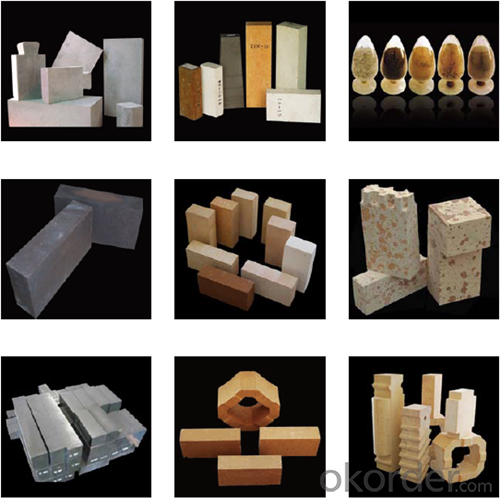
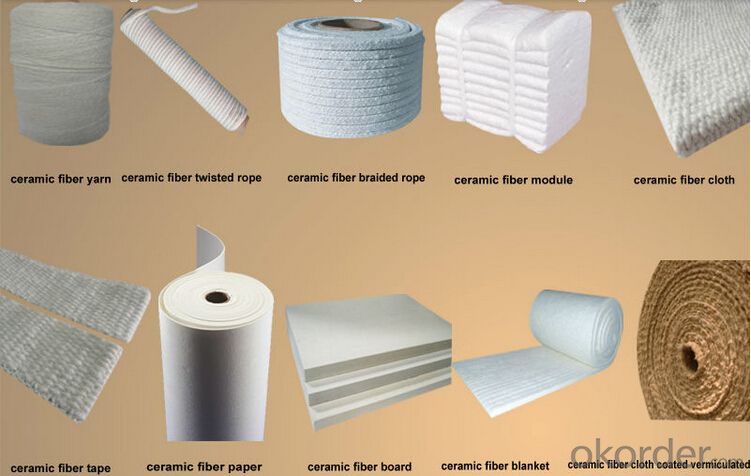
About us
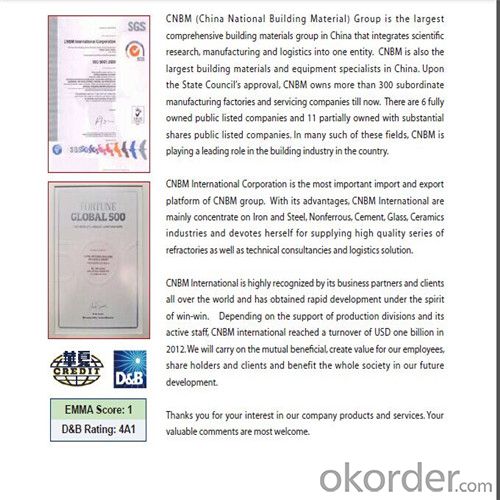
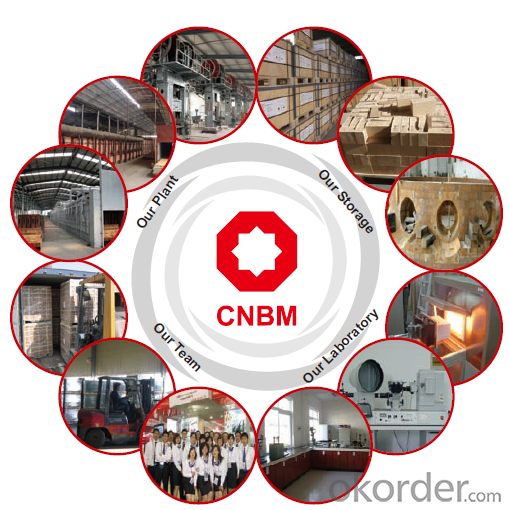
Sample is on your request.
Welcome to visit our factory~
- Q: How are monolithic refractories applied in the hot face and cold face of furnace linings?
- Monolithic refractories are applied in the hot face and cold face of furnace linings through different methods. For the hot face, monolithic refractories are typically sprayed or troweled onto the surface, forming a dense and heat-resistant layer. This layer protects the furnace from high temperatures and thermal shocks. In contrast, for the cold face, monolithic refractories are usually cast or gunned into place, creating a more insulating layer. This layer helps to maintain a lower temperature on the outer surface of the furnace lining. Overall, the application of monolithic refractories in both the hot face and cold face ensures optimal performance and durability of furnace linings.
- Q: How do monolithic refractories withstand high temperatures and thermal cycling?
- Monolithic refractories, with their unique composition and structural characteristics, are designed to endure high temperatures and thermal cycling. To begin with, these refractories are composed of high-quality raw materials like alumina, silica, and magnesia. These materials possess exceptional thermal properties, including high melting points and low thermal conductivity. Consequently, they can maintain their strength and integrity even in extreme temperatures. Additionally, monolithic refractories are engineered to have a dense and compact microstructure. This dense structure prevents the infiltration of heat and gases, minimizing thermal shock and crack formation. Moreover, the compact microstructure enhances the refractory's thermal conductivity, allowing it to efficiently distribute and dissipate heat. Furthermore, special additives and bonding agents are often incorporated into monolithic refractories to enhance their resistance to thermal cycling. These additives improve the refractory's thermal expansion properties, enabling it to expand and contract without cracking or spalling during rapid temperature changes. Some bonding agents also provide flexibility to the refractory, allowing it to withstand thermal stresses without compromising its structural integrity. In addition to these inherent characteristics, proper installation techniques are crucial for the refractory's ability to withstand high temperatures and thermal cycling. Careful application and curing ensure uniformity and minimize the development of internal stresses. Adequate curing and heat treatment processes create a strong and durable bond between the refractory and the substrate, enhancing its resistance to thermal shock and cyclic thermal loading. In summary, the composition, microstructure, and installation techniques of monolithic refractories work together to enable them to withstand high temperatures and thermal cycling. These factors result in excellent thermal conductivity, resistance to thermal shock, and the ability to expand and contract without compromising the refractory's structural integrity.
- Q: How do monolithic refractories perform in rotary hearth furnace applications?
- Monolithic refractories are known for their excellent performance in rotary hearth furnace applications. These refractories are designed to withstand the extreme temperatures and harsh conditions found in rotary hearth furnaces, making them an ideal choice for this specific application. One of the main advantages of monolithic refractories is their ability to resist thermal shock. In a rotary hearth furnace, the material being processed is subjected to rapid heating and cooling cycles, which can cause significant thermal stress on the refractory lining. Monolithic refractories have high thermal conductivity and low thermal expansion, allowing them to withstand these temperature fluctuations without cracking or spalling. Another key characteristic of monolithic refractories is their excellent abrasion resistance. In a rotary hearth furnace, the material being processed can contain abrasive particles that can erode the refractory lining over time. Monolithic refractories are formulated with high-quality aggregates and binders that offer superior resistance to abrasion, ensuring a longer service life for the lining. Furthermore, monolithic refractories have good chemical resistance, making them suitable for a wide range of applications in rotary hearth furnaces. They can withstand exposure to various chemical substances, such as molten metals, slags, and gases, without undergoing significant chemical reactions or degradation. This chemical stability ensures that the refractory lining remains intact and maintains its performance in the demanding environment of a rotary hearth furnace. Additionally, monolithic refractories offer excellent installation flexibility. Unlike traditional brick or tile refractories, which require complex installation procedures, monolithic refractories can be easily shaped and applied in-situ using various methods, such as gunning, casting, or ramming. This flexibility allows for quicker and more efficient lining repairs or replacements, reducing downtime and maintenance costs. In conclusion, monolithic refractories are highly reliable and efficient in rotary hearth furnace applications. Their ability to resist thermal shock, abrasion, and chemical attack, coupled with their easy installation, make them the preferred choice for lining materials in these demanding environments.
- Q: How do monolithic refractories impact the quality and performance of iron and steel products?
- Monolithic refractories play a crucial role in ensuring the quality and performance of iron and steel products. These refractories are specifically designed to withstand extremely high temperatures and harsh conditions, making them an essential component in various applications within the iron and steel industry. Firstly, monolithic refractories contribute to the overall quality of iron and steel products by providing excellent thermal insulation. They help to maintain a consistent and controlled temperature environment in the manufacturing process. This is particularly important in blast furnaces, where temperatures can reach up to 2,000 degrees Celsius. By effectively insulating the furnace walls, monolithic refractories help to minimize heat loss and ensure efficient energy utilization. This ultimately leads to higher-quality products with improved mechanical properties. Secondly, monolithic refractories offer superior resistance to chemical and physical wear. In the steelmaking process, molten metal and slag can be highly corrosive, causing erosion and degradation of the refractory lining. Monolithic refractories are specifically engineered to withstand these aggressive environments, providing excellent resistance to chemical attack and mechanical stress. By maintaining the integrity of the lining, they prevent contamination and prolong the lifespan of the furnace or ladle, ultimately enhancing the quality of the final iron and steel products. Furthermore, monolithic refractories enable greater design flexibility and ease of installation. Unlike traditional refractory bricks, which require meticulous placement and fitting, monolithic refractories can be applied as a single, cohesive material. This allows for more complex shapes and structures, resulting in optimized furnace design and improved thermal efficiency. Additionally, the ease of installation reduces downtime during maintenance and repairs, ensuring continuous production and minimizing disruptions to the production process. Overall, monolithic refractories significantly impact the quality and performance of iron and steel products. They provide excellent thermal insulation, resist chemical and physical wear, and offer greater design flexibility. By ensuring consistent and controlled temperature environments, preventing contamination, and enabling efficient production processes, monolithic refractories contribute to the production of high-quality iron and steel products that meet the stringent requirements of various industries.
- Q: How do monolithic refractories resist chemical corrosion in iron and steel applications?
- Monolithic refractories resist chemical corrosion in iron and steel applications through their inherent properties and composition. They are designed to have high chemical stability and resistance to react with molten metals, slag, and other corrosive substances present in these applications. Additionally, monolithic refractories are usually formulated with specific additives and binders that enhance their resistance to chemical attack. This combination of properties and composition allows them to withstand the aggressive environment of iron and steel applications without significant degradation or corrosion.
- Q: How do monolithic refractories withstand the mechanical impacts in furnace door applications?
- Monolithic refractories have been specially designed to endure the mechanical impacts experienced in furnace door applications as a result of their unique properties and composition. These refractories are manufactured from a solitary piece of material, which eliminates the necessity for joints or seams that are susceptible to cracking or failure under mechanical stress. An essential characteristic of monolithic refractories is their elevated density, which grants them exceptional strength and resistance against mechanical impacts. Their compact structure makes them less prone to cracking or fracturing when exposed to sudden or repeated impacts, such as the opening or closing of a furnace door. Along with their density, monolithic refractories also possess substantial tensile strength and toughness. These qualities enable them to absorb and disperse the energy from mechanical impacts, reducing the likelihood of damage or failure. This is particularly crucial in furnace door applications, where the refractories are constantly subjected to the stress of door movement. Moreover, monolithic refractories frequently incorporate additives or bonding agents that enhance their mechanical properties. These additives may consist of fibers or aggregates that fortify the structure and improve impact resistance. They can also enhance the refractory's ability to endure thermal cycling, which is common in furnace door applications. Overall, monolithic refractories are meticulously engineered to withstand the mechanical impacts encountered in furnace door applications. Their dense composition with high strength, combined with the utilization of additives and bonding agents, guarantees their durability and longevity in these demanding environments.
- Q: What are the advantages of using monolithic refractories in electric arc furnaces?
- There are several advantages of using monolithic refractories in electric arc furnaces. Firstly, monolithic refractories offer superior thermal shock resistance, allowing them to withstand rapid temperature changes without cracking or failing. This is crucial in electric arc furnaces where the temperature can fluctuate significantly during the melting process. Additionally, monolithic refractories have excellent corrosion resistance, which is essential in electric arc furnaces that often come into contact with corrosive molten metals and slag. They can withstand the corrosive effects, ensuring longer service life and reduced maintenance costs. Moreover, monolithic refractories provide ease of installation and repair. Unlike traditional bricks, they can be easily shaped and applied in various furnace designs, minimizing installation time and labor costs. In case of any damage, they can also be easily patched or replaced, allowing for quicker repairs and reduced downtime. Lastly, monolithic refractories offer improved energy efficiency due to their lower thermal conductivity. This means that less heat is lost to the surroundings, resulting in higher operational efficiency and reduced energy consumption. Overall, the advantages of using monolithic refractories in electric arc furnaces include superior thermal shock and corrosion resistance, ease of installation and repair, and improved energy efficiency, making them a preferred choice for these high-temperature industrial applications.
- Q: How are monolithic refractories different from traditional refractory materials?
- Monolithic refractories are different from traditional refractory materials in several ways. Firstly, while traditional refractory materials are typically made from bricks, blocks, or tiles, monolithic refractories are composed of a single, continuous material. This means that they do not have any joints or seams, which can be a weak point in traditional refractory structures. Secondly, monolithic refractories are much easier to install compared to traditional refractory materials. They can be easily shaped and applied in situ, allowing for greater flexibility in design and construction. In contrast, traditional refractory materials require skilled labor and more time-consuming installation methods such as bricklaying. Furthermore, monolithic refractories offer improved thermal shock resistance. Due to their continuous structure, they can better withstand sudden changes in temperature without cracking or spalling. Traditional refractory materials, on the other hand, may be more susceptible to thermal shock damage. Another advantage of monolithic refractories is their ability to provide better insulation. Their composition often includes lightweight aggregates or insulating fibers, which help to reduce heat loss and improve energy efficiency. Traditional refractory materials, while still capable of providing insulation, may not offer the same level of thermal efficiency. Lastly, monolithic refractories have the advantage of being more cost-effective. Their ease of installation, reduced labor requirements, and improved thermal performance contribute to lower overall project costs compared to traditional refractory materials. In summary, monolithic refractories differ from traditional refractory materials in terms of their continuous structure, ease of installation, improved thermal shock resistance, better insulation properties, and cost-effectiveness. These characteristics make them a preferred choice in many industries where high-temperature applications and thermal insulation are required.
- Q: What are the benefits of using monolithic refractories in the iron and steel industry?
- Using monolithic refractories in the iron and steel industry has several advantages. Firstly, they have excellent thermal shock resistance, meaning they can withstand extreme temperature changes without cracking or spalling. This is crucial in an industry where materials are exposed to high temperatures during processes such as melting, casting, and heat treatment. Secondly, monolithic refractories have superior corrosion resistance, making them highly durable against the corrosive effects of molten metals and slag. This is particularly important in the iron and steel industry, where materials come into contact with aggressive molten iron, steel, and various chemical compounds. Furthermore, monolithic refractories provide excellent mechanical strength and abrasion resistance. They can withstand mechanical stress, vibrations, and impacts commonly encountered in the iron and steel industry. This ensures a longer lifespan for the refractories, reduces downtime for repairs or replacements, and improves overall operational efficiency. Additionally, monolithic refractories offer ease of installation and repair. Unlike traditional refractory bricks that require complex and time-consuming masonry work, monolithic refractories can be quickly and easily installed using simple methods such as casting, gunning, or spraying. This saves time and labor costs during initial installation and subsequent maintenance or repairs. Moreover, monolithic refractories provide flexibility in design and application. They can be customized to specific shapes and sizes, allowing for tailored linings in different parts of the iron and steel manufacturing process. This versatility enhances the overall efficiency and effectiveness of refractory linings, optimizing production output and ensuring consistent quality of the finished iron and steel products. In conclusion, there are numerous benefits to using monolithic refractories in the iron and steel industry. They offer exceptional thermal shock resistance, corrosion resistance, mechanical strength, and abrasion resistance. They are also easy to install and repair, and their flexibility allows for customized designs. Overall, monolithic refractories contribute to improved productivity, reduced downtime, and enhanced product quality in the iron and steel industry.
- Q: How do monolithic refractories withstand the thermal cycling in aluminum smelting applications?
- Monolithic refractories have been specifically developed to endure the extreme thermal cycling conditions that arise in aluminum smelting applications. The exceptional properties of these refractories enable them to withstand the rapid and repetitive heating and cooling cycles without experiencing significant damage or failure. A key characteristic of monolithic refractories is their remarkable thermal shock resistance, which allows them to withstand sudden temperature changes without cracking or spalling. Throughout the aluminum smelting process, the refractories are exposed to extreme temperatures when molten aluminum is poured into the molds or when the molten metal comes into contact with the refractory lining. It is essential for the refractories to quickly absorb and dissipate heat to prevent any thermal shock damage. Furthermore, monolithic refractories possess a high thermal conductivity, which facilitates the efficient transfer of heat away from the refractory lining. This effectively reduces the risk of thermal stress and thermal fatigue. By dispersing the heat generated during the smelting process, the refractories minimize temperature variations within the lining, thereby preventing the occurrence of cracks or fractures. Moreover, monolithic refractories exhibit excellent chemical resistance, a crucial characteristic in aluminum smelting applications. These refractories are formulated to resist the corrosive effects of molten aluminum and other chemicals present in the smelting process. By offering resistance to chemical corrosion, the refractories help maintain the integrity of the refractory lining and extend its service life. Additionally, monolithic refractories are often reinforced with fibers or other structural materials to enhance their mechanical strength and durability. These reinforcements provide added resistance against mechanical stresses, such as thermal expansion and contraction, which arise during the thermal cycling process. In conclusion, the purpose of monolithic refractories is to withstand the thermal cycling conditions encountered in aluminum smelting applications. Their exceptional thermal shock resistance, high thermal conductivity, excellent chemical resistance, and enhanced mechanical strength enable them to endure extreme temperature fluctuations without experiencing significant damage. These refractories play a crucial role in maintaining the integrity and efficiency of the smelting process in the aluminum industry.
Send your message to us
Monolithic Refractories Ladle Sliding Gate for Iron and Steel Industry 2024
- Loading Port:
- Shanghai
- Payment Terms:
- TT OR LC
- Min Order Qty:
- 100 pc
- Supply Capability:
- 1000 pc/month
OKorder Service Pledge
OKorder Financial Service
Similar products
Hot products
Hot Searches
Related keywords
